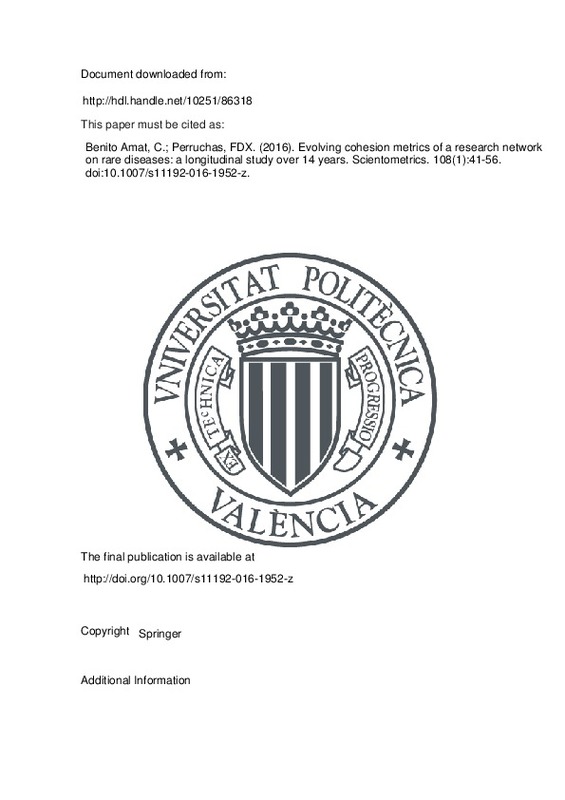Aymé, S., & Schmidtke, J. (2007). Networking for rare diseases: A necessity for Europe. Bundesgesundheitsblatt - Gesundheitsforschung - Gesundheitsschutz, 50(12), 1477–1483. doi: 10.1007/s00103-007-0381-9 .
Barabási, A. L., Jeong, H., Néda, Z., Ravasz, E., Schubert, A., & Vicsek, T. (2002). Evolution of the social network of scientific collaborations. Physica A: Statistical Mechanics and its Applications, 311(3–4), 590–614. doi: 10.1016/S0378-4371(02)00736-7 .
Bettencourt, L. M. A., Kaiser, D. I., & Kaur, J. (2009). Scientific discovery and topological transitions in collaboration networks. Journal of Informetrics, 3(3), 210–221. doi: 10.1016/j.joi.2009.03.001 .
[+]
Aymé, S., & Schmidtke, J. (2007). Networking for rare diseases: A necessity for Europe. Bundesgesundheitsblatt - Gesundheitsforschung - Gesundheitsschutz, 50(12), 1477–1483. doi: 10.1007/s00103-007-0381-9 .
Barabási, A. L., Jeong, H., Néda, Z., Ravasz, E., Schubert, A., & Vicsek, T. (2002). Evolution of the social network of scientific collaborations. Physica A: Statistical Mechanics and its Applications, 311(3–4), 590–614. doi: 10.1016/S0378-4371(02)00736-7 .
Bettencourt, L. M. A., Kaiser, D. I., & Kaur, J. (2009). Scientific discovery and topological transitions in collaboration networks. Journal of Informetrics, 3(3), 210–221. doi: 10.1016/j.joi.2009.03.001 .
Bian, J., Xie, M., Topaloglu, U., Hudson, T., Eswaran, H., & Hogan, W. (2014). Social network analysis of biomedical research collaboration networks in a CTSA institution. Journal of Biomedical Informatics, 52, 130–140. doi: 10.1016/j.jbi.2014.01.015 .
Bordons, M., Aparicio, J., González-Albo, B., & Díaz-Faes, A. A. (2015). The relationship between the research performance of scientists and their position in co-authorship networks in three fields. Journal of Informetrics, 9(1), 135–144. doi: 10.1016/j.joi.2014.12.001 .
Börner, K., Dall’Asta, L., Ke, W., & Vespignani, A. (2005). Studying the emerging global brain: Analyzing and visualizing the impact of co-authorship teams. Complexity, 10(4), 57–67. doi: 10.1002/cplx.20078 .
Casey-Campbell, M., & Martens, M. L. (2009). Sticking it all together: A critical assessment of the group cohesion–performance literature. International Journal of Management Reviews, 11(2), 223–246. doi: 10.1111/j.1468-2370.2008.00239.x .
Chiocchio, F., & Essiembre, H. (2009). Cohesion and performance: A meta-analytic review of disparities between project teams, Production teams, and service teams. Small group research, 40(4), 382–420. doi: 10.1177/1046496409335103 .
Cho, A. (2011). Particle physicists’ new extreme teams. Science, 333(6049), 1564–1567. doi: 10.1126/science.333.6049.1564 .
Cooke, N. J., & Hilton, M. L. (2015). Enhancing the effectiveness of team science. Washington, D.C.: National Academies Press. Recuperado a partir de http://www.nap.edu/catalog/19007/enhancing-the-effectiveness-of-team-science .
Cugmas, M., Ferligoj, A., & Kronegger, L. (2015). The stability of co-authorship structures. Scientometrics, 106(1), 163–186. doi: 10.1007/s11192-015-1790-4 .
Estrada, E. (2011). The structure of complex networks: Theory and applications. Oxford: University Press.
Gallivan, M., & Ahuja, M. (2015). Co-authorship, homophily, and scholarly influence in information systems research. Journal of the Association for Information Systems, 16(12), 980.
Ghosh, J., Kshitij, A., & Kadyan, S. (2014). Functional information characteristics of large-scale research collaboration: Network measures and implications. Scientometrics, 102(2), 1207–1239. doi: 10.1007/s11192-014-1475-4 .
Heymann, S. (2014). Gephi. In R. Alhajj & J. Rokne (Eds.), Encyclopedia of social network analysis and mining (pp. 612–625). New York: Springer.
Himmelstein, D. S., & Powell, K. (2016). Analysis for “the history of publishing delays” blog post v1.0. Zenodo,. doi: 10.5281/zenodo.45516 .
Hunt, J. D., Whipple, E. C., & McGowan, J. J. (2012). Use of social network analysis tools to validate a resources infrastructure for interinstitutional translational research: A case study. Journal of the Medical Library Association, 100(1), 48–54. doi: 10.3163/1536-5050.100.1.009 .
Kolaczyk, E. D., & Csardi, G. (2014). Statistical analysis of network data with R (Vol. 65). New York: Springer.
Kumar, S. (2015). Efficacy of a giant component in co-authorship networks: Evidence from a Southeast Asian dataset in economics. Aslib Journal of Information Management, 68(1), 19–32. doi: 10.1108/AJIM-12-2014-0172 .
Larivière, V., Gingras, Y., Sugimoto, C. R., & Tsou, A. (2015). Team size matters: Collaboration and scientific impact since 1900. Journal of the Association for Information Science and Technology, 66(7), 1323–1332. doi: 10.1002/asi.23266 .
Laudel, G. (2002). What do we measure by co-authorships? Research Evaluation, 11(1), 3–15. doi: 10.3152/147154402781776961 .
Liu, X., Bollen, J., Nelson, M. L., & Van de Sompel, H. (2005). Co-authorship networks in the digital library research community. Information Processing and Management, 41(6), 1462–1480. doi: 10.1016/j.ipm.2005.03.012 .
Liu, P., & Xia, H. (2015). Structure and evolution of co-authorship network in an interdisciplinary research field. Scientometrics, 103(1), 101–134. doi: 10.1007/s11192-014-1525-y .
Ministerio de Sanidad y Consumo. Resolución de 30 de marzo de. (2006) del Instituto de Salud Carlos III, por la que se convocan ayudas destinadas a financiar estructuras estables de investigación cooperativa, en el área de biomedicina y ciencias de la salud, en el marco de la iniciativa Ingenio 2010, programa Consolider, acciones CIBER, 83 Boletín Oficial del Estado (pp. 13770–13777).
Newman, M. E. J. (2001a). Scientific collaboration networks. II. Shortest paths, weighted networks, and centrality. Physical Review E, 64(1), 016132. doi: 10.1103/PhysRevE.64.016132 .
Newman, M. E. J. (2001b). Scientific collaboration networks. I. Network construction and fundamental results. Physical Review E, 64(1), 016131. doi: 10.1103/PhysRevE.64.016131 .
Newman, M. E. J. (2003a). Mixing patterns in networks. Physical Review E, 67(2), 026126. doi: 10.1103/PhysRevE.67.026126 .
Newman, M. E. J. (2003b). The structure and function of complex networks. SIAM Review, 45, 167–256.
OECD. (2010). Measuring innovation: A new perspective. Paris: OCDE Publishing.
Ramasco, J., & Morris, S. (2006). Social inertia in collaboration networks. Physical Review E, 73(1), 016122. doi: 10.1103/PhysRevE.73.016122 .
Sonnenwald, D. H. (2007). Scientific collaboration. Annual Review of Information Science and Technology, 41(1), 643–681. doi: 10.1002/aris.2007.1440410121 .
Wuchty, S., Jones, B. F., & Uzzi, B. (2007). The increasing dominance of teams in production of knowledge. Science, 316(5827), 1036–1039. doi: 10.1126/science.1136099 .
[-]







![[Cerrado]](/themes/UPV/images/candado.png)


